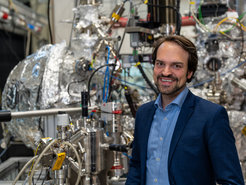Dr. Niels Schröter wins ERC Starting Grant
The European Research Council (ERC) has announced its Starting Grants for 2023. One of these coveted grants worth 2.4 million Euro is awarded to Dr. Niels Schröter, research group leader at the Max Planck Institute of Microstructure Physics in Halle. His ERC grant “ChiralTopMat” will explore a new class of structurally chiral topological materials that could lead to novel energy-efficient memory technologies.

This is the first ERC Starting Grant to be hosted at the Max Planck Institute of Microstructure Physics. ChiralTopMat aims to provide the direct experimental observation of chiral spin-hedgehogs in structurally chiral crystals and to explore ways to control their properties for applications in magnetic memory devices. Moreover, another focus will be to test the stability of topological Berry curvature monopoles against strong electronic interactions that Schröter’s group recently discovered in a chiral topological semimetal, a material that combines structural and electronic chirality.
“The concept of chirality can be understood when looking at our hands: Our left hand is a mirror image of the right, but they cannot be brought to coincide with each other by rotations or translations. The term chirality is derived from the Greek word for ‘hand’ χειρ (kheir) and generally describes objects that are distinct from their own mirror image. It is long known that chirality plays a crucial role in nature, providing powerful functionality to chiral molecules in living organisms. Our goal is now to extend this concept from the molecular to the solid state to discover new chirality-enabled functionalities in crystals that could form the basis for new technologies.” – explains Schröter.
The regular arrangement of atoms in crystals can also display a chirality, for instance when atoms form a spiral staircase that winds either clockwise or anticlockwise through the crystal structure. Recently, Schröter and collaborators discovered that such structurally chiral crystals can host novel electronic excitations [1] for which the wave function also becomes chiral. This initial finding has led to the discovery of the strongest Berry curvature monopoles that have ever been observed in the electronic band structure of a crystal [2].
„The ERC grants are the gold standard of European research funding. Those who prevail in this highly competitive process have demonstrated enormous expertise and convinced with a forward-looking topic. I am very pleased that Dr. Niels Schröter is bringing the next ERC Starting Grant to Saxony-Anhalt and wish him every success in his research on innovative materials and memory technologies.” congratulates Armin Willingmann, Minister for Science, Energy, Climate Protection and the Environment of the State of Saxony-Anhalt.
The majority of the grant will finance postdoctoral research fellows and Ph.D. students to collaborate with Niels Schröter on this research program, who comments “I am very excited by ChiralTopMat, which aims to discover fundamentally new phenomena in chiral crystals that have the potential to make a real-world impact. I am looking forward to collaborating with scientists from Germany and around the world to make this vision a reality.”
About the Starting Grant of the European Research Council
The fundamental activity of the ERC is to provide attractive, long-term funding to support excellent investigators and their research teams to pursue groundbreaking, high-gain/high-risk research. Due to the high level of competition and the focus on research excellence, a successful application to the European Research Council is very prestigious and is often considered a high honor for the researcher.
In the current application round, the European Research Council has awarded Starting Grants to 400 scientists based across Europe with 2-7 years of experience since the completion of their Ph.D. Each grant will enable the high-profile researchers and their teams to pursue their project ideas which are considered excellent.
A total of 2,696 research proposals reached the ERC in the last round of Starting Grants, of which 14.8 percent were approved. The ERC provides 628 million euros for this purpose, which come from the EU Framework Program for Research and Innovation Horizon Europe.
About the ERC
The ERC, set up by the European Union in 2007, is the premier European funding organization for excellent frontier research. It funds creative researchers of any nationality and age to run projects based across Europe. The ERC offers four core grant schemes: Starting Grants, Consolidator Grants, Advanced Grants, and Synergy Grants. With its additional Proof of Concept Grant scheme, the ERC helps grantees to bridge the gap between their pioneering research and early phases of its commercialization. The ERC is led by an independent governing body, the Scientific Council. The overall ERC budget from 2021 to 2027 is more than €16 billion, as part of the Horizon Europe program, under the responsibility of the European Commissioner for Innovation and Research, Margrethe Vestager.
(KW)












